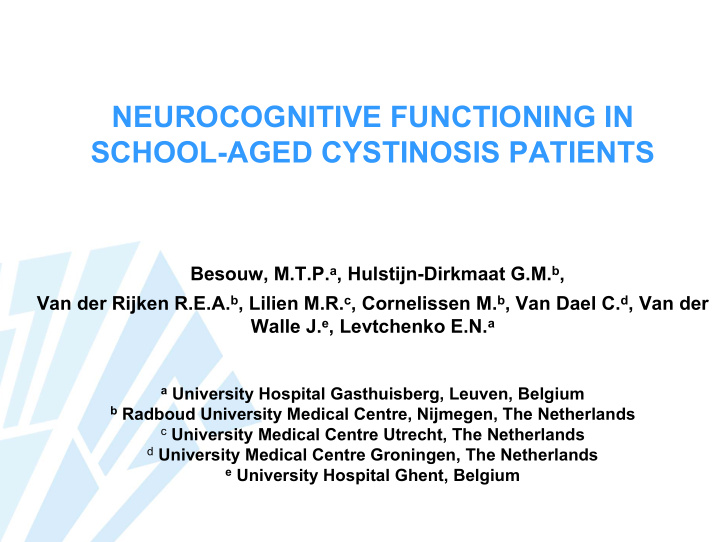



NEUROCOGNITIVE FUNCTIONING IN SCHOOL-AGED CYSTINOSIS PATIENTS Besouw, M.T.P. a , Hulstijn-Dirkmaat G.M. b , Van der Rijken R.E.A. b , Lilien M.R. c , Cornelissen M. b , Van Dael C. d , Van der Walle J. e , Levtchenko E.N. a a University Hospital Gasthuisberg, Leuven, Belgium b Radboud University Medical Centre, Nijmegen, The Netherlands c University Medical Centre Utrecht, The Netherlands d University Medical Centre Groningen, The Netherlands e University Hospital Ghent, Belgium
Cystinosis • 1:200,000 live births • Mutation CTNS gene encoding cystinosin • Renal Fanconi syndrome, end stage renal disease • Multi-organ involvement (including cornea crystals, hypothyroidism, diabetes mellitus, hypogonadism, myopathy, central nervous system)
Cystinosis cystinosin cytoplasm cytoplasm cysteine – cystine cysteamine cysteine cysteamine NH 2 COOH lysosome NH 2 COOH CH SH CH HS CH 2 lysosome CH 2 CH 2 CH 2 S + + S CH 2 S CAT CH S NH 2 CH 2 transporter NH 2 COOH CH 2 CH CH 2 cystine NH 2 COOH NH 2 cysteine transporter
Neurocognitive functioning • Normal intelligence (Verbal > Performance) • Visual information processing • Tactile recognition • Poor school results (spelling, arithmetic) •Trauner,D.A., Chase,C., Scheller,J., Katz,B., & Schneider,J.A. Neurologic and cognitive deficits in children with cystinosis. J. Pediatr. 112, 912-914 (1988). •Wolff,G., Ehrich,J.H., Offner,G., & Brodehl,J. Psychosocial and intellectual development in 12 patients with infantile nephropathic cystinosis. Acta Paediatr. Scand. 71, 1007-1011 (1982). •Spilkin et al. Visual and verbal learning in a genetic metabolic disorder. Neuropsychologia 47 (2009) 1883–1892 •Ulmer et al. Intellectual and motor performance, quality of life and psychosocial adjustment in children with cystinosis. Pediatric Nephrology, in press.
Neurocognitive functioning • Cystine accumulation in brain tissue? • Cysteamine passage of blood-brain barrier? •Broyer,M. et al. Clinical polymorphism of cystinosis encephalopathy. Results of treatment with cysteamine. J. Inherit. Metab Dis. 19, 65-75 (1996). •Bava et al. Developmental changes in cerebral white matter microstructure in a disorder of lysosomal storage. Cortex, in press. •Maurice et al. Cystine accumulation in the CNS results in severe age-related memory deficits. Neurobiology of aging, in press. •Berger et al. Cystinosis of the brain and spinal cord with associated vasculopathy. Journal of the Neurological Sciences, in press.
Aim Analysis of the neurocognitive functioning and renal status of European, school-aged cystinosis patients in order to identify specific deficits which can lead to learning difficulties.
Patients • 14 school-aged cystinosis patients • 13 native kidney 1 pre-emptive kidney transplantation • GFR 22-156 ml/min/1.73m 2
Methods • WISC-III Intelligence (full scale, verbal, performance) • Developmental test of visual-motor integration (VMI) Visual-motor integration skills • Stroop color-word test Concentration Interference • Bourdon-Vos test Sustained attention Speed Accuracy
Methods • Rey-Osterrieth complex figure Planning Visual memory • Computerized drawing task Processing speed Motor planning Fluency Motor speed • Child Behavior Checklist (CBCL) Behavioral/Emotional functioning
Results • IQ Mean full scale IQ 90.2 (range 60-132) Mean verbal IQ 93.9 Mean performance IQ 88.4 Verbal IQ >> Performance IQ: 5 patients Performance IQ >> Verbal IQ: 0 patients
Results • Visual-motor coordination Poor score 8/14 patients (57%) • Visual memory Poor score 8/14 patients (57%) • Processing speed Poor score 9/13 patients (69%) • Planning Poor score in 8/14 patients (57%) • Teacher: problems in 2 or more areas 7/14 patients (50%)
Conclusions • Visual-motor integration and executive (planning) functions are at risk in cystinosis patients. • Neurocognitive diagnostics aimed at these functions are indicated in all patients from the age of 7-8 years. • Early recognition and supervision from special education services can diminish learning difficulties and improve school carrier. • The role of brain involvement in cystinosis and the effect of cysteamine on brain tissue remains unclear.
Recommend
More recommend